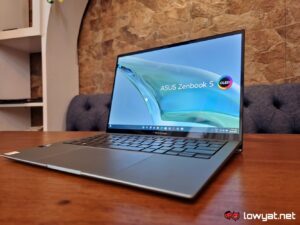ASUS Zenbook S13 OLED Hands On: Thin And Light Redux

Earlier yesteday morning – by that, I mean just after midnight – ASUS pulled back the veil from the Zenbook S13 OLED, the latest addition to its thin and light form factor line of laptops. As the rule of succession goes, this new model comes with improved hardware, new features, and an updated design.
So, let’s start with the aesthetics of the S13 OLED. As if laptops in this lineup could not get any smaller, ASUS somehow managed to bend the laws of physics again, not to outdo the predecessor, but to maintain most of what is already impressive about this laptop. Overall, the laptop weighs in at a mere 1kg, allowing it to retain its title as one of the lightest laptops in the world. The most impressive part of the new laptop, though, is just how much thinner the brand has made it. when close, the laptop is just a little over 1cm thick. 1.09 cm, to be precise.

While that may not seem impressive to some, it is still a feat of engineering, especially when you think about how ASUS managed to reduce the overall thickness by another 0.4cm, all while still having some space for its internal hardware. On that note, this year’s thin-and-light makes a return to Intel, after a very brief tryst with AMD’s Ryzen 6000 Series. The model I had a brief hands-on with was fitted with an Intel EVO Core i5-1335U, but it is available in a configuration with a Core i7-1355U.
The main processor out of the way, the other internal components of the S13 OLED include 16GB DDR5-5200 RAM, up to 1TB of storage from an NVMe Gen4 SSD – the Core i5 model comes with half that at 512GB – and a 13.3-inch 2.8K Lumina OLED display panel, which also comes in the 16:10 aspect ratio. In case you’re wondering, Lumina is the name of the brand’s display technology reserved for the Zenbook line, while Nebula is the technology you’ll hear for laptops in the ROG range.


Ports-wise, the S13 OLED doesn’t have a whole lot going for it but because it’s returned to being an Intel EVO-based laptop, there is Thunderbolt 4 support, and that comes in the form of two USB-C ports. Despite its 1cm thickness, there’s still room for a USB-A 3.2 Gen2 port and an HDMI 2.1 port, For wireless connectivity, it’s got Wi-Fi 6E goodness and Bluetooth 5.2.
That aside, I can briefly move on to the back of the S13 OLED, of which you’ll find that the Zenbook logo has been completely redesigned, blown up if you will, and the rocket symbol now takes up half the space, but does look more avant-garde. It’s a nice touch, but the real star of the show here is that Plasma Ceramic Aluminium chassis. It’s a mouthful to say, no doubt, but ASUS says that the new material and coating warrant much better protection against fingerprint smudges. Honestly, the texture feels as if I’m running my fingers through a powdered-coated tile.

As for the performance of the S13 OLED; while I didn’t spend as long as I liked with it, I can tell you that it was fast and snappy and responded really quickly. The display feels really bright too, even with the brightness level reduced to 50% of its 550 nits peak brightness. Typing on its keyboard really feels like a daily affair, with key travel feeling a little on the shallow side but to be fair, there’s only so much you can improve upon a keyboard built in a chassis this thin anyway. Likewise, the larger trackpads gives my fingers all the glide I want.
As much as I would like to talk about the S13 OLED’s battery life, my short and brief period with it isn’t enough for me decide if it is good or bad enough. As much as ASUS touts it as having a 14-hour battery life, my experience with Intel’s current range of 13th Gen Raptor Lake mobile CPUs genuinely has me wondering if these U-Series processor will fare worse or actually live up to the claim. In any case, I will need to conduct a more in-depth review of the laptop, in order to ascertain if it is indeed a productivity machine or not.
Photography by John Law.









The post ASUS Zenbook S13 OLED Hands On: Thin And Light Redux appeared first on Lowyat.NET.
